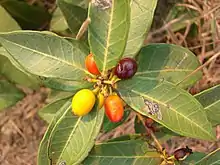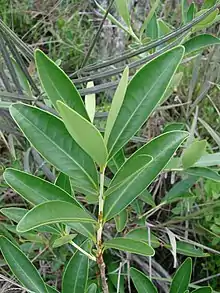Eugenia calycina
Eugenia calycina, also known as savannah cherry, field cherry, Jabuti cherry, Grao de galo, cerejinha, cereja de cerrado, pitanga-vermelha, red pitanga, pitanga cherry of cerrado, and ca-ajaboti, is a flowering shrub in the family Myrtaceae.[1] The specific epithet (calycina) comes from Latin calycinus, meaning having a notable calyx.
| Eugenia calycina | |
|---|---|
 | |
| Fruiting Eugenia calycina plant | |
| Scientific classification | |
| Kingdom: | Plantae |
| Clade: | Tracheophytes |
| Clade: | Angiosperms |
| Clade: | Eudicots |
| Clade: | Rosids |
| Order: | Myrtales |
| Family: | Myrtaceae |
| Genus: | Eugenia |
| Species: | E. calycina |
| Binomial name | |
| Eugenia calycina Cambess. (1832) | |
| Varieties | |
|
Eugenia calycina var. herbacea (O.Berg) Mattos | |
| Synonyms | |
| |
Distribution
Eugenia calycina is native to Brazil, including but not exclusive to the states of Goiás, São Paulo, Minas Gerais, Mato Grosso do Sul, and Paraná.[2] It grows wild in savannahs and fields up to 1,600 meters (5,200 feet) in elevation, especially in drier areas.[1]
Description
Eugenia calycina grows up to 2 meters (6.6 feet) in height, although is normally between 0.7 and 1.5 meters (2.3 and 4.9 feet). The narrow, coriaceous leaves are evergreen and elliptic in shape. The flowers are pinkish-white with four round petals. They arise to new settlements on the side or edge among the stalks and measure 1.5–5.8 centimeters (0.59–2.28 inches) in length. The oblong fruit is dark red to purple when ripe and measures 2.5 centimeters (0.98 inches) in length and 1.5 centimeters (0.59 inches) in width. There are at least two pointed, cordate-based, ovate bracts measuring 0.9–2.2 centimeters (0.35–0.87 inches) in length at the base of each fruit. It is edible and said to have a mild, sweet, berry-like flavor. It contains a single recalcitrant seed which germinates after 30–45 days of being planted. Seedling growth is rapid, with the plant often reaching 20 centimeters (7.9 inches) at 10 months of age. It fruits from November to January and flowers in spring. Fruiting begins when the plant is 2–3 years of age. The plant prefers positions in full sun or partial shade and tolerates semi-arid, rainy temperate, and subtropical to tropical dry and wet climates. They tolerate frost down to −4 °C (25 °F) and tolerate heat to 42 °C (108 °F). It tolerates sandy-loam soils and sand soils with quartz. The pH level of the soil may range from 4.5 to 6.7, with some moisture.[3][4]
Uses
The fruit is often gathered from the wild and eaten raw or made into jellies and sweets.[1] It is used by native people to treat diabetes.[5]
Chemistry
The fruit is rich in vitamin A.[3] Several sesquiterpenes have been identified from the leaves of Eugenia calycina: bicyclogermacrene, spathulenol, beta-caryophyllene, aromadendrane‐4β,10α‐diol, and 1β‐11‐dihydroxy‐5‐eudesmene. The cytotoxic concentrations of the essential oil in the leaves for HeLa and Vero cells (266.8 ± 46.5 and 312.1 ± 42.5 μg mL−1) in 48 hours of exposure were higher than the LC50, which shows low cytotoxicity at the concentration exhibiting larvicidal activity. This indicates that the essential oil of Eugenia calycina shows high activity against the larvae of Aedes aegypti but has lower cytotoxicity against mammalian cells. Therefore, the leaves of Eugenia calycina are a promising source of natural larvicide.[6] The seeds, fruit pulp, and leaves contain a high phenolic content, with ellagic acid being the main compound with values of 8244.53 µg/g dw (leaves), 5054.43 µg/g dw (pulp), and 715.42 µg/g dw (seed). The total phenolic content in the leaves, pulp, and seed is 20371.96, 7139.70, and 2204.75 µg/g dw, with the main compounds being ellagic acid, myricitrin, and epicatechin gallate. The leaves, pulp, and seeds contain 153 different phytochemicals belonging to different chemical classes, including organic acids, phenolic acids, flavonoids, and others. Eugenia calycina has high potential as a plant food due to its high phenolic content and phytochemical profile.[5] It also contains a number of oxygen-containing compounds such as fatty acids, steroids, and tannins. Compounds with high amounts of oxygen (such as glycosed flavonoids, tannins, and polyphenolic compounds) were revealed to show activity against Cryptococcus sp. D (minimum inhibitory concentration=15.62μg/mL). It was also revealed that compounds contained a decreased amount of oxygen (such as fatty acids and steroids) towards Cryptococcus gattii L48, Cryptococcus neoformans L3 (MIC=31.2μg/mL), and Cryptococcus sp. D (MIC=62.5μg/mL). Therefore, Eugenia calycina has potential for research of active substances that can be used for treatment of cryptococcosis.[7]
References
- "Eugenia calycina - Useful Tropical Plants". tropical.theferns.info. Retrieved 13 March 2021.
- "Eugenia calycina Cambess". www.gbif.org. Retrieved 13 March 2021.
- "Eugenia calycina and punicifolia". www.bananasraras.org. Retrieved 13 March 2021.
- "Savanna Cherry Eugenia Calycina Dark Red Fruit Tropical Tree Plant RARE". eBay. Retrieved 13 March 2021.
- Peixoto Araujo, Nayara Macêdo; Arruda, Henrique Silvano; dos Santos, Fábio Neves; de Morais, Damila Rodrigues; Pereira, Gustavo Araujo; Pastore, Glaucia Maria (1 November 2020). "LC-MS/MS screening and identification of bioactive compounds in leaves, pulp and seed from Eugenia calycina Cambess". Food Research International. 137: 109556. doi:10.1016/j.foodres.2020.109556. ISSN 0963-9969. PMID 33233178.
- Silva, Marcus VSG; Silva, Sheila A.; Teixera, Thaise Lara; Oliveira, Alberto De; Morais, Sérgio AL; Silva, Claudio Vieira Da; Espindola, Laila S.; Sousa, Raquel MF (2021). "Essential oil from leaves of Eugenia calycina Cambes: Natural larvicidal against Aedes aegypti". Journal of the Science of Food and Agriculture. 101 (3): 1202–1208. doi:10.1002/jsfa.10732. ISSN 1097-0010. PMID 32789937. S2CID 221127361. Retrieved 13 March 2021.
- Ferreira, Fernanda P. S.; Morais, Sandra R.; Bara, Maria T. F.; Conceição, Edemilson C.; Paula, José R.; Carvalho, Thays C.; Vaz, Boniek G.; Costa, Helber B.; Romão, Wanderson; Rezende, Maria H. (October 2014). "Eugenia calycina Cambess extracts and their fractions: Their antimicrobial activity and the identification of major polar compounds using electrospray ionization FT-ICR mass spectrometry". Journal of Pharmaceutical and Biomedical Analysis. 99: 89–96. doi:10.1016/j.jpba.2014.07.003. ISSN 1873-264X. PMID 25108373. Retrieved 14 March 2021.
